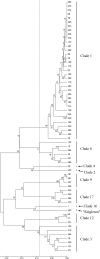Candidemia surveillance in Brazil: evidence for a geographical boundary defining an area exhibiting an abatement of infections by Candida albicans group 2 strains
- PMID: 20592158
- PMCID: PMC2937723
- DOI: 10.1128/JCM.00262-10
Candidemia surveillance in Brazil: evidence for a geographical boundary defining an area exhibiting an abatement of infections by Candida albicans group 2 strains
Abstract
Prospective population surveillance has been conducted for candidemia in Brazil (A. L. Colombo, M. Nucci, B. J. Park, et al., J. Clin. Microbiol. 44:2816-2823, 2006). In the present study, a total of 63 isolates from 61 patients, representing 11 medical centers from nine geographic regions, were characterized by multilocus sequence typing (MLST). A total of 48 unique profiles or diploid sequence types (DSTs) were observed, with nine new sequence types (STs) and 32 new DSTs. There were no apparent correlations between center/region and DST patterns. Subtypes were compared to those in a known characterized reference set, including a large database of strains obtained worldwide. Significantly, only one C. albicans group 2 isolate was found in our collection, although isolates from this particular group are commonly found worldwide. These data, combined with information from other previously reported studies, establish a statistically significant diminishment of group 2 strains in Central and South America, including Mexico and portions of the Southwestern United States.
Figures


Similar articles
-
Multilocus sequence typing of sequential Candida albicans isolates from patients with persistent or recurrent fungemia.Med Mycol. 2010 Aug;48(5):757-62. doi: 10.3109/13693780903501689. Med Mycol. 2010. PMID: 20105100
-
Genetic diversity among Korean Candida albicans bloodstream isolates: assessment by multilocus sequence typing and restriction endonuclease analysis of genomic DNA by use of BssHII.J Clin Microbiol. 2011 Jul;49(7):2572-7. doi: 10.1128/JCM.02153-10. Epub 2011 May 11. J Clin Microbiol. 2011. PMID: 21562112 Free PMC article.
-
Typing of Candida isolates from patients with invasive infection and concomitant colonization.Scand J Infect Dis. 2010;42(2):109-13. doi: 10.3109/00365540903348336. Scand J Infect Dis. 2010. PMID: 19902993
-
Multilocus sequence typing of Candida albicans: strategies, data exchange and applications.Infect Genet Evol. 2004 Sep;4(3):243-52. doi: 10.1016/j.meegid.2004.06.002. Infect Genet Evol. 2004. PMID: 15450203 Review.
-
Molecular diagnosis and epidemiology of fungal infections.Med Mycol. 1998;36 Suppl 1:249-57. Med Mycol. 1998. PMID: 9988514 Review.
Cited by
-
Genetic diversity of medically important and emerging Candida species causing invasive infection.BMC Infect Dis. 2015 Feb 13;15:57. doi: 10.1186/s12879-015-0793-3. BMC Infect Dis. 2015. PMID: 25887032 Free PMC article.
-
Molecular fingerprints to identify Candida species.Biomed Res Int. 2013;2013:923742. doi: 10.1155/2013/923742. Epub 2013 Jun 17. Biomed Res Int. 2013. PMID: 23844370 Free PMC article. Review.
-
Multilocus sequence typing of Candida albicans isolates from the oral cavities of patients undergoing haemodialysis.Sci Rep. 2018 Nov 6;8(1):16413. doi: 10.1038/s41598-018-34565-7. Sci Rep. 2018. PMID: 30401875 Free PMC article.
-
Clonal Strain Persistence of Candida albicans Isolates from Chronic Mucocutaneous Candidiasis Patients.PLoS One. 2016 Feb 5;11(2):e0145888. doi: 10.1371/journal.pone.0145888. eCollection 2016. PLoS One. 2016. PMID: 26849050 Free PMC article.
-
Particular Candida albicans strains in the digestive tract of dyspeptic patients, identified by multilocus sequence typing.PLoS One. 2012;7(4):e35311. doi: 10.1371/journal.pone.0035311. Epub 2012 Apr 20. PLoS One. 2012. PMID: 22536371 Free PMC article.
References
Publication types
MeSH terms
Substances
LinkOut - more resources
Full Text Sources
Medical

